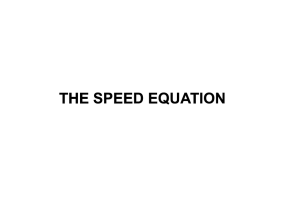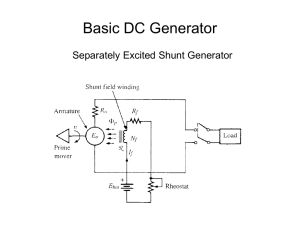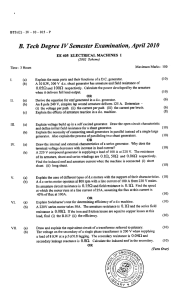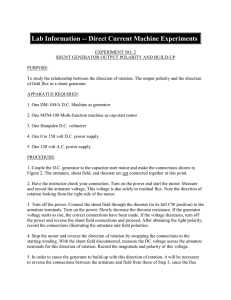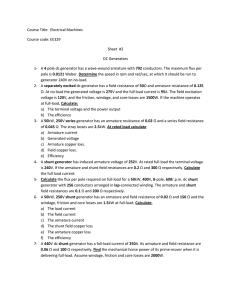SET
advertisement
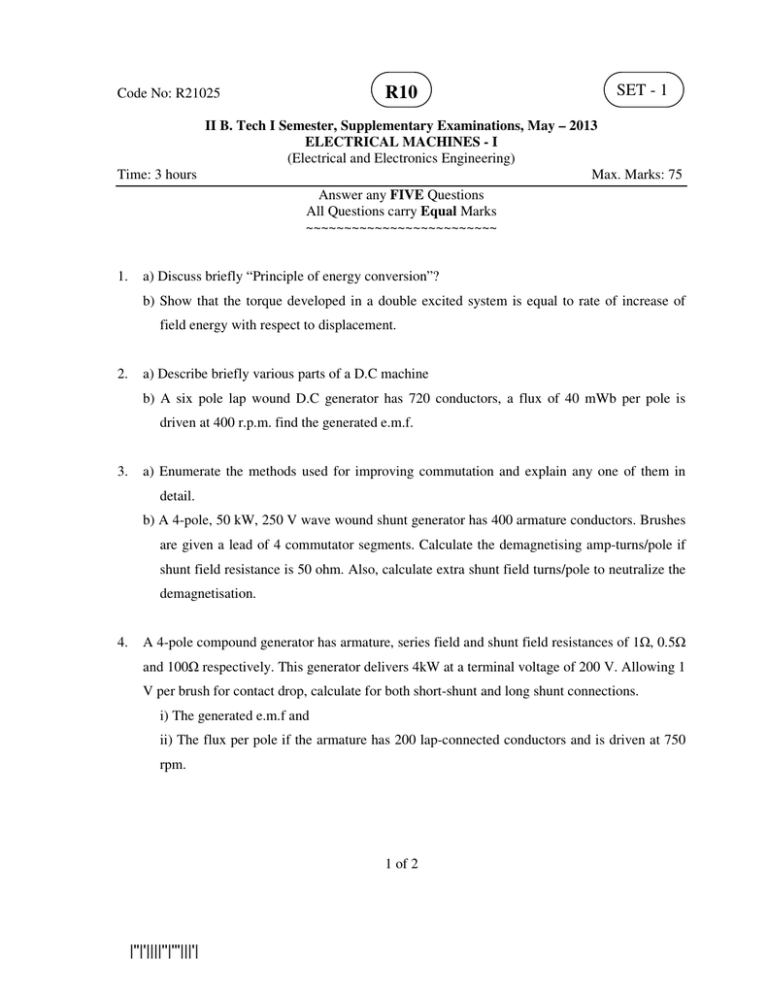
Code No: R21025 R10 SET - 1 II B. Tech I Semester, Supplementary Examinations, May – 2013 ELECTRICAL MACHINES - I (Electrical and Electronics Engineering) Time: 3 hours Max. Marks: 75 Answer any FIVE Questions All Questions carry Equal Marks ~~~~~~~~~~~~~~~~~~~~~~~~~ 1. a) Discuss briefly “Principle of energy conversion”? b) Show that the torque developed in a double excited system is equal to rate of increase of field energy with respect to displacement. 2. a) Describe briefly various parts of a D.C machine b) A six pole lap wound D.C generator has 720 conductors, a flux of 40 mWb per pole is driven at 400 r.p.m. find the generated e.m.f. 3. a) Enumerate the methods used for improving commutation and explain any one of them in detail. b) A 4-pole, 50 kW, 250 V wave wound shunt generator has 400 armature conductors. Brushes are given a lead of 4 commutator segments. Calculate the demagnetising amp-turns/pole if shunt field resistance is 50 ohm. Also, calculate extra shunt field turns/pole to neutralize the demagnetisation. 4. A 4-pole compound generator has armature, series field and shunt field resistances of 1Ω, 0.5Ω and 100Ω respectively. This generator delivers 4kW at a terminal voltage of 200 V. Allowing 1 V per brush for contact drop, calculate for both short-shunt and long shunt connections. i) The generated e.m.f and ii) The flux per pole if the armature has 200 lap-connected conductors and is driven at 750 rpm. 1 of 2 |''|'||||''|'''|||'| Code No: R21025 5. R10 SET - 1 a) What important conditions must be fulfilled before a shunt generator is connected in parallel with another? b) Two shunt generators are operated in parallel. The e.m.f induced in one machine is 260V and that induced in the other machine is 270V. They supply together a load current of 1800A. If each machine has an armature resistance of 0.04Ω and field resistance of 50Ω, Determine: i) Terminal voltage and 6. ii) Output of each machine a) What is torque? And what is the source of the torque force in a D.C. motor? Explain. b) The field current of a 10kW, 230V, 1500 rpm DC shunt motor is adjusted so that it runs at a no-load speed of 1600 rpm with an armature current of 2A. When load on motor is increased, it is observed that armature current is 40A and speed is 1400 rpm. Under these conditions, find the percentage reduction in field flux per pole due to armature reaction. The armature circuit resistance is 1 ohm and supply voltage is 230 V. 7. Why is a resistor required in series with the armature of a DC motor at the time of starting? Describe a suitable starter for starting a DC shunt motor having No-volt and overload protections. 8. Explain the Swinburne’s test to determine no-load losses of a DC machine. What are the limitations of this test? 2 of 2 |''|'||||''|'''|||'| Code No: R21025 R10 SET - 2 II B. Tech I Semester, Supplementary Examinations, May – 2013 ELECTRICAL MACHINES - I (Electrical and Electronics Engineering) Time: 3 hours Max. Marks: 75 Answer any FIVE Questions All Questions carry Equal Marks ~~~~~~~~~~~~~~~~~~~~~~~~~ 1. a) Explain “Principle of energy conversion”. b) For a singly excited magnetic field system, derive the relation for the magnetic stored energy. 2. a) Give the advantages and uses of lap and wave windings b) The armature of 6-pole D.C generator has a wave winding containing 664 conductors. Calculate the generated e.m.f., when the flux per pole is 60 mWb and the speed is 250 r.p.m. Find the speed at which the armature must be driven to generate an e.m.f of 550 V if the flux/pole is reduced to 58 mWb. 3. a) What are the causes of sparking in DC machines? b) A 200 kW, 8-pole wave connected 440 V shunt generator has 720 armature conductors and a shunt field current of 7.5 A. Find the demagnetising and cross-magnetising AT/pole, if the brushes are given a lead of 20 electrical degrees. Find the number of additional shunt field turns to neutralize the demagnetising effect. 4. a) What features of dc series generator distinguish it from other types of dc generators? Explain. b) The terminal voltage of separately excited DC generator with constant excitation is constant and is equal to 250 V. Determine the percentage reduction in speed when the load changes from 300kW to 200kW. The armature resistance is 0.01Ω and total contact drop at brushes = 2V. Neglect armature reaction 1 of 2 |''|'||||''|'''|||'| Code No: R21025 5. R10 SET - 2 In a certain sub-station, there are 5 DC generators in parallel, each having an armature resistance of 0.1 Ω, running at the same speed and excited to give equal induced e.m.fs. Each generator supplies an equal share of total load of 250kW at a terminal voltage of 500V into a load of fixed resistance. If the field current of one generator is raised by 4%, the other remaining unchanged, calculate the power output of each machine and their terminal voltages under these conditions. Assume the speed remains constant and flux is proportional to field current. 6. A 6-pole, 230 V DC series motor has a flux per pole of 4mWb/Amp over the working range of the magnetisation curve which is assumed to be linear. The load torque is proportional to speed squared and its value is 20 N-m at 800 rpm. There are 432 wave-connected conductors and the total resistance of motor is 1.0 Ω. Determine the motor speed and current when this motor is connected to rated supply voltage. 7. a) Explain the working principle of a 3-point starter of a DC shunt motor. b) A 230 V dc shunt motor takes an armature current of 20 A on a certain load. Resistance of armature is 0.5 Ω. Find the resistance required in series with the armature to halve the speed if i) the load torque is constant ii) the load torque is proportional to the square of the speed. 8. Describe the Hopkinson’s test for obtaining the efficiency of two similar shunt motors. 2 of 2 |''|'||||''|'''|||'| R10 Code No: R21025 SET - 3 II B. Tech I Semester, Supplementary Examinations, May – 2013 ELECTRICAL MACHINES - I (Electrical and Electronics Engineering) Time: 3 hours Max. Marks: 75 Answer any FIVE Questions All Questions carry Equal Marks ~~~~~~~~~~~~~~~~~~~~~~~~~ 1. Explain briefly an electromechanical energy conversion device with the help of a block diagram. 2. Draw the developed winding diagram of lap winding for 6 poles, 18 slots with two coils sides/slot, double layer showing therein position of poles, direction of motion, direction of generated e.m.f and position of brushes. 3. a) Give the concept of reactance voltage in DC machines. Discuss how reactance voltage causes under commutation in DC machines. b) A 6-pole 40 kW, 500 V, wave connected DC generator has 480 conductors on its armature. The brushes are shifted by an angle of 9 mechanical degrees to eliminate sparking on the commutator when delivering full load current. Calculate i) Demagnetising ampere turns/pole. And ii) Cross-magnetising ampere-turns/pole. 4. a) Explain different methods of excitation of DC generator with suitable diagrams b) In a 220-v compound generator; the armature, series and shunt windings have resistance of 0.25Ω, 0.15Ω and 50Ω respectively. The load consists of 100 lamps; each rated at 60W, 220 V. Find the total e.m.f. and armature current when the machine is connected for i) long shunt and ii) short shunt. 1 of 2 |''|'||||''|'''|||'| Code No: R21025 5. SET - 3 R10 Two compound generators G1 and G2 (fitted with an equalizing bar) operating in parallel supply a load of 475 A. The data of these generators are as follows: G1 G2 Generated e.m.fs., V 250 254 Series field resistance, ohm 0.004 0.006 Armature resistance, ohm 0.02 0.04 Determine: i) Current in each armature ii) Current in each series winding iii) The current flowing in the equalizing bar iv) The bus bar voltage Neglect the shunt field current. 6. a) Differentiate between the generator action and motor action of a D.C. machine. b) The input to a 220 V D.C. shunt motor is 11 kW. The other particulars of the motor are: No load current = 5 A; No load speed= 1150 rpm. Armature resistance= 0.5 Ω; shunt field resistance=110 Ω. Calculate: i) torque developed ii) efficiency iii) speed at this load. 7. A DC shunt motor driving a centrifugal pump whose torque varies as the square of the speed. The motor is fed from a 220V supply and takes 50A when running at 1000 rpm. What resistance must be inserted in the armature circuit in order to reduce the speed to 800 rpm? The armature and field resistances of motor are 0.1 Ω and 100 Ω respectively. 8. a) Classify various losses in a DC machine and indicate the factors on which these depend. b) The hysteresis and eddy current loss in dc machine running at 1000 rpm are 250 W and 100 W respectively. If the flux remains constant, at what speed will the total iron losses be halved? 2 of 2 |''|'||||''|'''|||'| Code No: R21025 R10 SET - 4 II B. Tech I Semester, Supplementary Examinations, May – 2013 ELECTRICAL MACHINES - I (Electrical and Electronics Engineering) Time: 3 hours Max. Marks: 75 Answer any FIVE Questions All Questions carry Equal Marks ~~~~~~~~~~~~~~~~~~~~~~~~~ 1. The below figure shows the magnetic circuit consisting of a single-coil stator and an oval rotor. The coil inductance varies with rotor angle position, measured between the magnetic axis of the stator coil and major axis of rotor, as L(θ) =L0+L2 cos(2θ), where L0=10.6 mH and L2=2.7 mH. Find the torque as a function of θ for a coil current of 2A. 2. a) Derive the e.m.f equation of a D.C generator. b) A four pole lap wound D.C armature has bore diameter 0.7 meter. It has 560 conductors and ratio of pole arc/pole pitch is 0.63. If the armature is running at 600 r.p.m. and the flux density in the air gap is 1.2 Wb/m2 determine the generated e.m.f in the armature if effective length of armature conductor is 20 cm. 3. a) What do you mean by armature reaction in DC machines? Show on a diagram its effect on the flux distribution. b) A 70 kW, 500 V, 4-pole wave wound DC generator has 620 armature conductors. The brushes are given an actual lead of 80 at full load. Calculate: i) Demagnetising AT /pole. And ii) Cross-magnetising AT /pole. 1 of 2 |''|'||||''|'''|||'| Code No: R21025 R10 SET - 4 4. a) Explain in detail the manner in which the terminal voltage of a DC shunt generator will vary when the load resistance is reduced steadily in Stages from infinity to zero. The speed is maintained constant and the resistance in the field circuit is unaltered after the initial adjustment. b) A series generator having a combined armature and field resistance of 0.4 Ω is running at 1,000 r.p.m. and delivering 5.5 kW at a terminal voltage of 110V. If the speed is raised to 1500 r.p.m. and load adjusted to 10kW, Find the new current and terminal voltage. Assume the machine is working on the straight line portion of the magnetisation characteristic. 5. a) What is an equalizer? When must it be used? b) Two shunt generators, each with a no load voltage of 125V are run in parallel. Their external characteristics can be taken as straight line over these operating ranges. Generator No: 1 is rated at 25kW and its full load voltage is 119V, Generator No: 2 is rated at 200kW at 116V. Calculate the bus-bar voltage when the total load is 3500A. How is the load divided between the two? 6. A 6-pole, 500- V wave- connected shunt motor has 1200 armature conductors and useful flux/pole of 20mWb. The armature and field resistance are 0.5 Ω and 250 Ω respectively. What will be the speed and torque developed by the motor when it draws 20 A from the supply mains? Neglect armature reaction. If magnetic and mechanical losses amount to 900 W, find i) Useful torque ii) Output in kW and iii) Efficiency at this load. 7. a) Enumerate the factors that influence the speed of the DC motor and explain how the speed of a DC motor may be varied above and below speed at which it runs with full load current. b) A series motor with series field and armature resistance of 0.06 Ω and 0.04 Ω respectively is connected across 220 V mains. The armature takes 40 A and its speed is 900 rpm. Calculate the speed when the armature takes 75 A from the same supply mains and the excitation is increased by 15%. 8. a) How may the rotational losses be estimated by retardation test? b) A 500 V, 25 HP, dc shunt motor takes 2.4 A while running light. The field and armature resistances are 650 Ω and 0.57 Ω respectively. Calculate full-load efficiency, assuming a brush drop of 2 V. 2 of 2 |''|'||||''|'''|||'|
